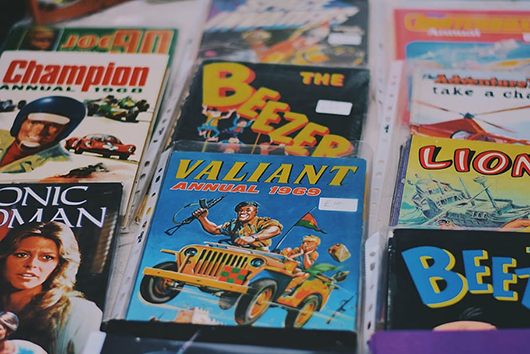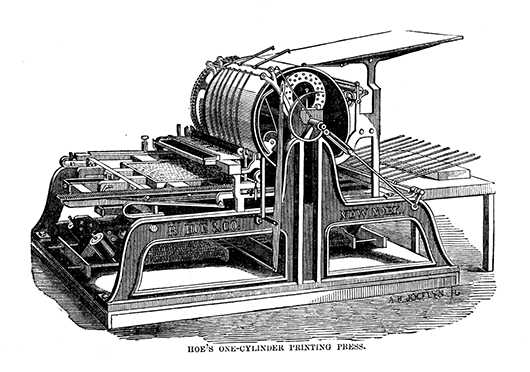The History of Comic Book Printing Dot By Dot
September 1, 2020
Humans have been telling stories through pictures since the days of cave paintings. Storytelling and human imagination are incredible gifts that allow us to build worlds inside our minds and express them through words and images.
A comic book is a story that's told in sequential pictures. One could argue that cave paintings are some of the earliest forms of comic books. However, most scholars believe that comic books are narratives represented by drawings, characters, text, describing dialogue and set, and as back story.
Comic books are also mass-produced and are transportable. Although cave paintings may represent the earliest examples of a story through pictures, they were not reproducible or portable.
The Early Years
Some of the earliest examples of visual narratives harken back to the Roman Empire. One precursor to modern comic books is Trajan's Column, which depicts the emperor's victories in the recent Dacian Wars through pictures.
Other examples might include hieroglyphs from Egypt, friezes from Greece, or pictorial scenes from the Bible. But these works did not come to the reader, nor could they be mass-produced. To print lots of comic books, you needed movable type in a printing press, and Europe wouldn't have this ability until the 15th century.
An additional definition of the modern comic book that it’s easily reproduced; up until the Gutenberg press, this ease was impossible. Although movable type facilitated the mass production of texts, was used in China by Bi Sheng in the 10th and 11th centuries, the letterpress printing method was not available in Europe until the 1440s.
The First Modern Comic Books
The first generally accepted comic book of the Western, modern world is The Adventures of Obadiah Oldbuck, although some argue that, in fact, The Glasgow Looking Glass, published in 1826, was the first one.
The Adventures of Obadiah Oldbuck was published in 1837 and translated into English four years later. The comic arrived in New York City as a side-stitched, 40-page book with six to twelve panels per page.
Another element that defines a comic book is that it is serial, or part of a larger story. One of the distinctions between graphic novels and comics is that the former may be part of a more extensive series, but each issue contains a full narrative; a comic book is usually part of a serialized succession of stories.
One of the first serialized, mass-produced comics was titled Ally Sloper's Half Holiday, which came out in Britain in 1867 as part of Judy’s, a humor magazine. This comic book was highly popular, especially with the working class, and had a circulation as broad as 350,000 people.
In the U.S., R.F. Outcault's work on The Yellow Kid and Hogan's Alley heralded the modern conception of comic books because his work appeared serially in newspapers and combined multi-image narratives and text bubbles.
Comic Books Go Mainstream
In the 1920s and ‘30s, comics became very popular in both the United States and Europe. Comic anthologies like Beano and The Dandy were making waves, and Hergé's The Adventures of Tintin became the newest addition to the weekly paper as a supplement.
Across the Atlantic, U.S.-based newspapers were expanding the fodder of comics to include not just humorous storylines, but also action-based comics, mysteries, or dramas. In 1929, this culminated in The Funnies, a compilation of reprinted newspaper comic strips.
The comic book that began it all was Action Comic #1, featuring Superman as its headliner. Superman and Clark Kent became the defining character(s) of American comic books, firmly establishing the superhero genre and launching what is known as the Golden Age of Comic Books.
Although comic books lost popularity in the 1950s for various reasons, their popularity surged in the 1960s and ‘70s. Today, the comic book and graphic novel are fully recognized as a modern type of literature.
Censorship and Comic Books
In the 1950s, the Comics Magazine Association established the Comics Code Authority to avoid censorship and regulation by the federal government. Some believed that comic books were detrimental for young people and would give them harmful examples to follow.
The CCA modeled its expectations on Wertham's Seduction of the Innocent, which laid out in no uncertain terms that comic books would harm America's youth. Senate hearings followed the 1954 publication of Wertham's book, and, fearing intense governmental reprisal, comic book publishers decided to form their own self-regulatory body, which became the CCA.
The CCA wasn't a law, so a publisher could choose whether or not they wanted to follow the code. It banned graphic depictions of gore, violence, and sexual innuendo. Unbelievably, the CCA lasted into the 21st century, with the final three comic book publishers – DC, Archie, and Bongo – breaking with the CCA in 2011.
Despite restrictions from the CCA, the 1960s and ‘70s are the Silver Age of comic book publishing, characterized by a steady influx of superhero tales, followed by the Bronze and Modern Ages.
In the 1980s or the Bronze Age, comic book storylines began to branch out and get darker and more serious. Anti-heroes like Batman became more popular, issuing in what some call the Dark Age of comics, which refers to the less-than-sunny plots of some of these stories.
Format Changes Over the Ages
Initially, comic books were printed on cheap paper by a newspaper press in four to five colors.
Most of these comics were printed with a process called “spot color,” which entails printing the graphic elements one color at a time, in "spots." This printing process was much more time-consuming than the full-color comic book printing methods used today, where all of the colors print simultaneously.
Since most comics in the early years did not have many pages, to create a comic, you would fold over the paper and trim it on three sides, creating a booklet. The binding would be stitched or stapled, much like saddle-stitched options of today. The cover would be coated paper, also trimmed to size.
The process of colorful printing graphics evolved into the Ben-Day Dot system, named after illustrator Benjamin Day. This process involves a dot pattern, either closely-spaced, overlapping, or placed far apart. This method, with color dots, halftone dots, and magenta dots that resemble art from Roy Lichtenstein, allows for more control over the hues and shading and more detailed work with halftone screens.
Comic Book Printing in the Modern Age
Today, comic books are printed quickly and efficiently using a multi-step color process. Comic book illustrators in the present era have a wide variety of color separations, mediums, and types of papers to choose from, allowing for much more creative freedom with their original art.
Most of the design and coloring work is done digitally; white paper is scanned into a computer where the artist chooses and applies different colors and shading techniques. Black and white images and black lines are inked first, and then pigment is added later.
To physically print a comic book with offset printing, the pages are laid out in the appropriate order and fed into the printer on rotating printing plates. Both sides are printed simultaneously, and this is repeated for each of the four colors in differing degrees and is called four-color printing.
Printed pages of the comic book (or one long roll of paper, depending on the process) are folded, stacked, cut to the right size, and bound with staples, stitching, or glue.

The Last Word
Although the comic book has seen its ups and downs throughout its existence, it has never completely gone away.
In the modern age, comic books and graphic novels are a legitimate literature genre, with graphic novels like Spiegelman's Maus introducing audiences to the more somber side of comic books.
If you're into graphic design and have been thinking about creating and printing your comic book, Comix Well Spring offers professional comic book printing services for comics artists. With a foundation of superb customer service, our professionals will lead you every step of the way.
The creative process is a journey, and the printing company Comix Wellspring will guide you through.

